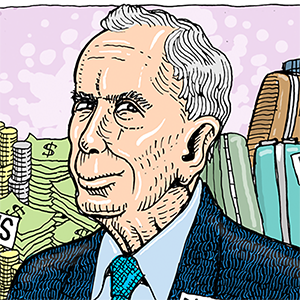Consumer
/Home & Leisure

Would-be Florida homebuyers getting cold feet? Many more are walking away from purchases
More homebuyers have been backing out of home-purchase agreements in many parts of Florida and across the U.S., a new analysis shows.
Florida and Texas are seeing more newly built homes “than anywhere else in the country,” leading some buyers to back out of deals because they feel they might find a better option, according to Redfin, a real...Read more
Real estate Q&A: How can we get neighbor to deal with constantly barking dog
Q: Ever since our new neighbor moved in six months ago, they have constantly left their dog out, and it never stops barking. We try to be patient, but it’s getting intolerable. What can we do? — Katya
A: Dealing with inconsiderate neighbors can be frustrating and stressful. For some people, it might be a barking dog; for others, it could be...Read more

Vacancies for life science office space hit record highs. Here's who's taking advantage
Vacancy rates for life science space are at record highs, and a few firms are capitalizing on the downturn.
The region’s core cluster vacancy rate is a record 31.2%, up from 20.4% a year ago, according to a report by commercial real estate firm Jones Lang LaSalle. Vying to fill vacant buildings, landlords are offering incentives like free ...Read more

Faced with a housing crisis, this southern Minnesota city is saying yes to experimental builds
NEW ULM, Minnesota – Leaders in this southern Minnesota city, famous for its German heritage, have adopted a new philosophy to combat its housing crisis: saying “ja.”
Over the past few months, the City Council in this town of about 14,000 has approved a flurry of housing projects, including nearly two-dozen shed houses in an industrial ...Read more

Chase to open new J.P. Morgan Financial Center for million-dollar customers on Michigan Avenue
CHICAGO — The remaking of North Michigan Avenue will take another step forward next year with the opening of a new two-story Chase/J.P. Morgan banking center in a former clothing store across from the Water Tower.
The high-traffic retail location at 830 N. Michigan Ave. will feature a Chase branch at street level and a J.P. Morgan Financial ...Read more

San Diego rents have fallen for 6 months, longest decline in 15 years
Average rents in San Diego County have fallen for six straight months and have reached a milestone not seen since in 15 years.
Rents are down 0.3% year-over-year to an average $2,520 per month in early December, said real estate tracker CoStar. San Diego County has not seen average rent decline on an annual basis since the end of 2010.
Of ...Read more

How this Florida barrier island community pushed back against overdevelopment
Picture this: A sandy, 25-mile stretch of beach, just a three-hour drive from Miami but devoid of grocery stores or gas stations, restaurants, bars or hotels. Instead, sea turtles nest on the beach, their hatchlings’ sense of orientation protected by dark-sky rules and by long-term residents who know to handle them with care on their extensive...Read more

UWM acquires mortgage servicer in $1.3 billion all-stock deal
In a move that significantly expands its footprint in the mortgage servicing landscape, Pontiac, Michigan-based United Wholesale Mortgage Holdings Corp. said Wednesday it would acquire Two Harbors Investment Corp. in an all-stock deal valued at $1.3 billion.
The merger combines United Wholesale Mortgage with Two Harbors, a real estate ...Read more

Amazon distribution center at LAX sells for record price
An Amazon warehouse near the gates of Los Angeles International Airport has sold for a record price as logistics centers near transportation hubs grow in value.
The real estate investment arm of global financial services firm Morgan Stanley recently paid $211 million for the distribution center on 98th Street amid several private long-term ...Read more

PayPal applies to become a bank as US loosens regulatory reins
PayPal Holdings Inc. applied to become a bank in the U.S., looking to take advantage of the Trump administration’s openness to financial-technology companies entering the banking system.
The payments-focused firm submitted applications to the Federal Deposit Insurance Corp. and the Utah Department of Financial Institutions to form a Utah-...Read more

11 AI-powered apps that help you save money
Most Americans feel uncomfortable with their emergency savings — and for good reason. According to Bankrate’s latest research, building a financial cushion feels impossible when you’re drowning in forgotten subscriptions, overpaying for everything and manually tracking expenses that slip through the cracks.
AI-powered finance apps solve ...Read more

The Fed cut interest rates again. We asked 5 experts what Americans should do next
The Federal Reserve lowered interest rates again at its final meeting of the year, signaling that Chair Jerome Powell was able to guide his deeply divided committee toward a consensus over how to manage an economy suffering from both higher inflation and unemployment.
The Federal Open Market Committee (FOMC) in December reduced its benchmark ...Read more

Private health insurance costs are going up. A complete guide to your coverage options
Private health insurance premiums will be going up in 2026 — in some cases, by a lot.
Congressional Democrats and Republicans remain deadlocked on health care reform, following disagreements over America’s health insurance marketplace that contributed to November’s government shutdown. At the heart of the issue is the extension of the ...Read more

What's important in affordable energy? Being comfortable in your home
PITTSBURGH — When Destenie Nock was in graduate school, earning her doctorate in industrial engineering at the University of Massachusetts Amherst, her electricity was shut off for nonpayment.
She and her roommates prioritized paying for fuel deliveries to their oil-heated home and had trouble catching up on other utility bills.
It wasn't ...Read more

Warner Bros. is blockbuster finale to $4.5 trillion M&A haul
Dealmakers are heading into the final weeks of 2025 on a $100 billion cliffhanger.
Paramount Skydance Corp.’s hostile bid to snatch Warner Bros. Discovery Inc. from under the nose of Netflix Inc. encapsulates the themes that have shaped a banner year for mergers and acquisitions: renewed desire for transformative tie-ups, massive checks from ...Read more

Stores, financial institutions come up short as penny production stops
DETROIT — Marie Shoulders of Detroit has a penny purse, a penny jar and a small penny pouch.
As a self-confessed penny hoarder, she wasn't surprised to hear about the scarcity of the reddish-brown copper-and-zinc coins.
"The pennies are short because people have them at home in they drawers, purses and everywhere. I keep them. ... There's ...Read more
Real estate Q&A: Can condo board keep me from renting if my credit score is barely too low?
Q: I’ve been having an issue while trying to rent a condo apartment. I have a good job, drive a nice car and have a credit score of 690. The condo’s board has refused to let me rent in their building because they say the rules require a minimum credit score of 700. Are they allowed to deny my application for this reason? —Gordon
A: Yes, ...Read more

California pro-housing group sues Newsom over duplex ban in wildfire zones
A pro-housing group sued Gov. Newsom on Wednesday over his decision to restrict SB 9, a housing law that allows owners to parcel up their properties, in the wake of the January fires.
YIMBY Law, a San Francisco-based organization, alleges that Newsom's executive order over the summer allowing cities to suspend SB 9 is a constitutional overreach...Read more

Rise in late auto loan payments signals stress on low-income families
The rise in late auto loan payments is a symptom of an increasingly unaffordable vehicle market, experts say. Households with the lowest incomes are suffering the most.
Auto loan debt is not yet at a crisis point, according to analysts. But economists are closely following late payments as a potential indicator of wider economic stress and ...Read more

More New Yorkers want apartments in the Philly area
More out-of-towners and fewer locals are searching for rental homes in the Philadelphia region, with New Yorkers leading the way. No word on whether they plan to become Eagles fans.
In an analysis of the country’s 50 largest metropolitan areas, Philadelphia had the second-largest drop in local rental demand since before the pandemic, as ...Read more
Popular Stories
- How this Florida barrier island community pushed back against overdevelopment
- 11 AI-powered apps that help you save money
- Would-be Florida homebuyers getting cold feet? Many more are walking away from purchases
- Real estate Q&A: How can we get neighbor to deal with constantly barking dog
- Vacancies for life science office space hit record highs. Here's who's taking advantage






